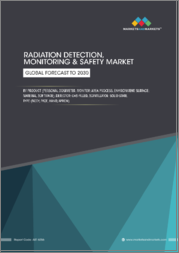
|
시장보고서
상품코드
1753965
신틸레이터 시장 보고서 : 재료 구성별, 최종 제품별, 용도별, 지역별(2025-2033년)Scintillator Market Report by Composition of Material, End Product, Application, and Region 2025-2033 |
||||||
신틸레이터 세계 시장 규모는 2024년 5억 9,030만 달러에 달했습니다. 향후 IMARC Group은 2033년까지 8억 4,160만 달러에 달할 것으로 예상하며, 2025년부터 2033년까지 3.98%의 연평균 성장률(CAGR)을 기록할 것으로 예측하고 있습니다.
신틸레이터는 고에너지 광자, 양성자, 전자, 중성자 등의 입사 입자를 흡수할 수 있는 물질을 말합니다. 일반적인 신틸레이터 재료에는 무기 및 유기 결정, 유기 액체, 희가스 및 신틸레이션 가스가 포함됩니다. 신틸레이터는 수집된 에너지를 가시광선 또는 자외선 영역의 광자로 변환하여 광전자증배관 또는 포토다이오드에 의한 검출을 보장합니다. 이 외에도, 신틸레이터는 입사 방사선의 에너지와 시간을 효율적으로 결정하는 데 도움이 됩니다. 다른 유형의 방사선 검출기와 비교할 때, 이러한 재료는 더 간단하고 신뢰할 수 있으며, 비용 효율적인 구조와 작동, 축적된 에너지에 더 민감하고, 더 빠른 응답 시간을 가지고 있습니다. 그 결과 원자력발전소, 의료용 영상처리, 제조업, 고에너지 입자 실험, 국가 안보 등 다양한 분야에서 활용되고 있습니다.
의료 산업에서 신틸레이터는 심혈관질환 및 신경 질환의 검출 및 분석에 사용됩니다. 이러한 질병의 발생이 증가함에 따라 전 세계적으로 신틸레이터에 대한 수요가 증가하고 있습니다. 또한, 전 세계 정부는 의료기기 사용에 대한 엄격한 규제를 시행하고 있으며, 그 결과 병원과 의료 기관이 기술적으로 진보된 신틸레이션 및 방사선 검출기를 채택하도록 압력을 가하고 있습니다. 또한, 이러한 재료는 국토안보를 강화하고 인명 손실을 피하기 위해 전 세계 보안 및 방위 기관에서 사용하고 있습니다. 예를 들어, 미국 국토안보부(DHS)는 방사성 물질 탐지 및 방사능 위협 방지를 위해 탐색 연구 프로그램 및 중소기업 혁신 연구 프로그램에 따라 고체 유기 신틸레이터 개발을 지원하고 있습니다.
본 보고서에서 다루는 주요 질문
- 신틸레이터 세계 시장은 지금까지 어떻게 성장해왔고, 앞으로 어떻게 성장할 것인가?
- 세계 신틸레이터 산업의 주요 지역 시장은?
- COVID-19가 세계 신틸레이터 산업에 미치는 영향은?
- 재료 구성별 시장 현황은?
- 용도별 시장 내역은?
- 최종 제품별 시장 분석은?
- 세계 신틸레이터 산업 가치사슬의 다양한 단계는 무엇인가?
- 세계 신틸레이터 산업의 주요 촉진요인과 과제는 무엇인가?
- 세계 신틸레이터 산업의 구조와 주요 업체는?
- 전 세계 신틸레이터 산업에서 경쟁의 정도는 어느 정도인가?
목차
제1장 서문
제2장 조사 범위와 조사 방법
- 조사 목적
- 이해관계자
- 데이터 소스
- 1차 정보
- 2차 정보
- 시장 추정
- 상향식 접근
- 하향식 접근
- 조사 방법
제3장 주요 요약
제4장 소개
- 개요
- 주요 업계 동향
제5장 세계의 신틸레이터 시장
- 시장 개요
- 시장 실적
- COVID-19의 영향
- 시장 내역 : 재질별
- 시장 내역 : 최종 제품별
- 시장 내역 : 용도별
- 시장 내역 : 지역별
- 시장 예측
제6장 시장 내역 : 재료 구성별
- 무기 신틸레이터
- 시장 내역 : 유형별
- 알칼리 할로겐화물
- 산화물계 신틸레이터
- 기타
- 시장 내역 : 유형별
- 유기 신틸레이터
- 시장 내역 : 유형별
- 단결정
- 액체 신틸레이터
- 플라스틱 신틸레이터
- 시장 내역 : 유형별
제7장 시장 내역 : 최종 제품별
- 개인용 또는 포켓 사이즈 계기
- 소지식 계기
- 고정형, 설치식, 자동식 계기
제8장 시장 내역 : 용도별
- 의료
- 원자력발전소
- 제조업
- 국토안보·방위
- 기타
제9장 시장 내역 : 지역별
- 북미
- 유럽
- 아시아태평양
- 중동 및 아프리카
- 라틴아메리카
제10장 SWOT 분석
- 개요
- 강점
- 약점
- 기회
- 위협
제11장 밸류체인 분석
제12장 Porter's Five Forces 분석
- 개요
- 구매자의 교섭력
- 공급 기업의 교섭력
- 경쟁 정도
- 신규 참여업체의 위협
- 대체품의 위협
제13장 가격 분석
제14장 경쟁 구도
- 시장 구조
- 주요 기업
- 주요 기업 개요
- Scintacor Ltd
- Hamamatsu Photonics K.K.
- Proterial, Ltd.(Hitachi Ltd.)
- Ludlum Measurements Inc.
- Mirion Technologies Inc.
- Radiation Monitoring Devices Inc.(Dynasil Corporation of America)
- Rexon Components, Inc.
- Zecotek Photonics Inc.
The global scintillator market size reached USD 590.3 Million in 2024. Looking forward, IMARC Group expects the market to reach USD 841.6 Million by 2033, exhibiting a growth rate (CAGR) of 3.98% during 2025-2033.
Scintillators refer to materials which can absorb high-energy photons and incident particles such as protons, electrons and neutrons. The common scintillator materials include inorganic and organic crystals, organic liquids, and noble and scintillating gases. They assist in converting the gathered energy into visible or ultraviolet range of photons which ensures detection by photomultipliers and photodiodes. Besides this, scintillators help in efficiently determining the energy and time of incident radiation. When compared to other types of radiation detectors, these materials are more sensitive to deposited energy and have a faster response time with simpler, reliable and cost-efficient construction and operation. As a result, they find vast applications in nuclear plants, medical imaging, manufacturing industries, high-energy particle experiments and national security.
In the healthcare industry, scintillators are used to detect and analyze cardiovascular and neurological diseases. With the increasing occurrence of these ailments, the demand for scintillators is increasing across the globe. Moreover, the governments across the globe are implementing stringent regulations on the use of medical devices which, in turn, is pressurizing hospitals and healthcare organizations to adopt technologically advanced scintillation and radiation detectors. Additionaly, these materials are used by security and defense organizations worldwide to tighten homeland security and avert human loss. For instance, the Department of Homeland Security (DHS) in the United States has been supporting the development of solid organic scintillators under the Exploratory Research and Small Business Innovative Research programs for detecting radioactive substances and preventing radiological threats.
Key Market Segmentation:
Breakup by Composition of Material:
- In-Organic Scintillators
- Alkali Halides
- Oxide Based Scintillators
- Others
- Organic Scintillators
- Single Crystal
- Liquid Scintillators
- Plastic Scintillators
Breakup by End Product:
- Personal or Pocket Size Instruments
- Hand-Held Instruments
- Fixed, Installed, and Automatic Instruments
Breakup by Application:
- Healthcare
- Nuclear Power Plants
- Manufacturing Industries
- Homeland Security and Defense
- Others
Breakup by Region:
- North America
- Europe
- Asia Pacific
- Middle East and Africa
- Latin America
Competitive Landscape:
The report has also analysed the competitive landscape of the market with some of the key players being Scintacor Ltd., Hamamatsu Photonics K.K., Proterial, Ltd. (Hitachi Ltd.), Ludlum Measurements Inc., Mirion Technologies Inc., Radiation Monitoring Devices Inc. (Dynasil Corporation of America), Rexon Components, Inc., Zecotek Photonics Inc., etc.
Key Questions Answered in This Report:
- How has the global scintillator market performed so far and how will it perform in the coming years?
- What are the key regional markets in the global scintillator industry?
- What has been the impact of COVID-19 on the global scintillator industry?
- What is the breakup of the market based on the composition of material?
- What is the breakup of the market based on the application?
- What is the breakup of the market based on the end product?
- What are the various stages in the value chain of the global scintillator industry?
- What are the key driving factors and challenges in the global scintillator industry?
- What is the structure of the global scintillator industry and who are the key players?
- What is the degree of competition in the global scintillator industry?
Table of Contents
1 Preface
2 Scope and Methodology
- 2.1 Objectives of the Study
- 2.2 Stakeholders
- 2.3 Data Sources
- 2.3.1 Primary Sources
- 2.3.2 Secondary Sources
- 2.4 Market Estimation
- 2.4.1 Bottom-Up Approach
- 2.4.2 Top-Down Approach
- 2.5 Forecasting Methodology
3 Executive Summary
4 Introduction
- 4.1 Overview
- 4.2 Key Industry Trends
5 Global Scintillator Market
- 5.1 Market Overview
- 5.2 Market Performance
- 5.3 Impact of COVID-19
- 5.4 Market Breakup by Composition of Material
- 5.5 Market Breakup by End Product
- 5.6 Market Breakup by Application
- 5.7 Market Breakup by Region
- 5.8 Market Forecast
6 Market Breakup by Composition of Material
- 6.1 In-Organic Scintillators
- 6.1.1 Market Trends
- 6.1.2 Market Breakup by Type
- 6.1.2.1 Alkali Halides
- 6.1.2.1.1 Market Trends
- 6.1.2.1.2 Market Forecast
- 6.1.2.2 Oxide Based Scintillators
- 6.1.2.2.1 Market Trends
- 6.1.2.2.2 Market Forecast
- 6.1.2.3 Others
- 6.1.2.3.1 Market Trends
- 6.1.2.3.2 Market Forecast
- 6.1.2.1 Alkali Halides
- 6.1.3 Market Forecast
- 6.2 Organic Scintillators
- 6.2.1 Market Trends
- 6.2.2 Market Breakup by Type
- 6.2.2.1 Single Crystal
- 6.2.2.1.1 Market Trends
- 6.2.2.1.2 Market Forecast
- 6.2.2.2 Liquid Scintillators
- 6.2.2.2.1 Market Trends
- 6.2.2.2.2 Market Forecast
- 6.2.2.3 Plastic Scintillators
- 6.2.2.3.1 Market Trends
- 6.2.2.3.2 Market Forecast
- 6.2.2.1 Single Crystal
- 6.2.3 Market Forecast
7 Market Breakup by End Product
- 7.1 Personal or Pocket Size Instruments
- 7.1.1 Market Trends
- 7.1.2 Market Forecast
- 7.2 Hand-Held Instruments
- 7.2.1 Market Trends
- 7.2.2 Market Forecast
- 7.3 Fixed, Installed, and Automatic Instruments
- 7.3.1 Market Trends
- 7.3.2 Market Forecast
8 Market Breakup by Application
- 8.1 Healthcare
- 8.1.1 Market Trends
- 8.1.2 Market Forecast
- 8.2 Nuclear Power Plants
- 8.2.1 Market Trends
- 8.2.2 Market Forecast
- 8.3 Manufacturing Industries
- 8.3.1 Market Trends
- 8.3.2 Market Forecast
- 8.4 Homeland Security and Defense
- 8.4.1 Market Trends
- 8.4.2 Market Forecast
- 8.5 Others
- 8.5.1 Market Trends
- 8.5.2 Market Forecast
9 Market Breakup by Region
- 9.1 North America
- 9.1.1 Market Trends
- 9.1.2 Market Forecast
- 9.2 Europe
- 9.2.1 Market Trends
- 9.2.2 Market Forecast
- 9.3 Asia Pacific
- 9.3.1 Market Trends
- 9.3.2 Market Forecast
- 9.4 Middle East and Africa
- 9.4.1 Market Trends
- 9.4.2 Market Forecast
- 9.5 Latin America
- 9.5.1 Market Trends
- 9.5.2 Market Forecast
10 SWOT Analysis
- 10.1 Overview
- 10.2 Strengths
- 10.3 Weaknesses
- 10.4 Opportunities
- 10.5 Threats
11 Value Chain Analysis
12 Porters Five Forces Analysis
- 12.1 Overview
- 12.2 Bargaining Power of Buyers
- 12.3 Bargaining Power of Suppliers
- 12.4 Degree of Competition
- 12.5 Threat of New Entrants
- 12.6 Threat of Substitutes
13 Price Analysis
14 Competitive Landscape
- 14.1 Market Structure
- 14.2 Key Players
- 14.3 Profiles of Key Players
- 14.3.1 Scintacor Ltd
- 14.3.2 Hamamatsu Photonics K.K.
- 14.3.3 Proterial, Ltd. (Hitachi Ltd.)
- 14.3.4 Ludlum Measurements Inc.
- 14.3.5 Mirion Technologies Inc.
- 14.3.6 Radiation Monitoring Devices Inc. (Dynasil Corporation of America)
- 14.3.7 Rexon Components, Inc.
- 14.3.8 Zecotek Photonics Inc.



















